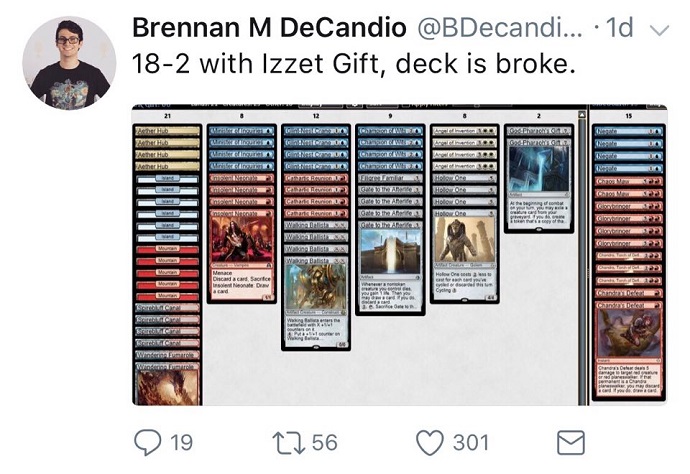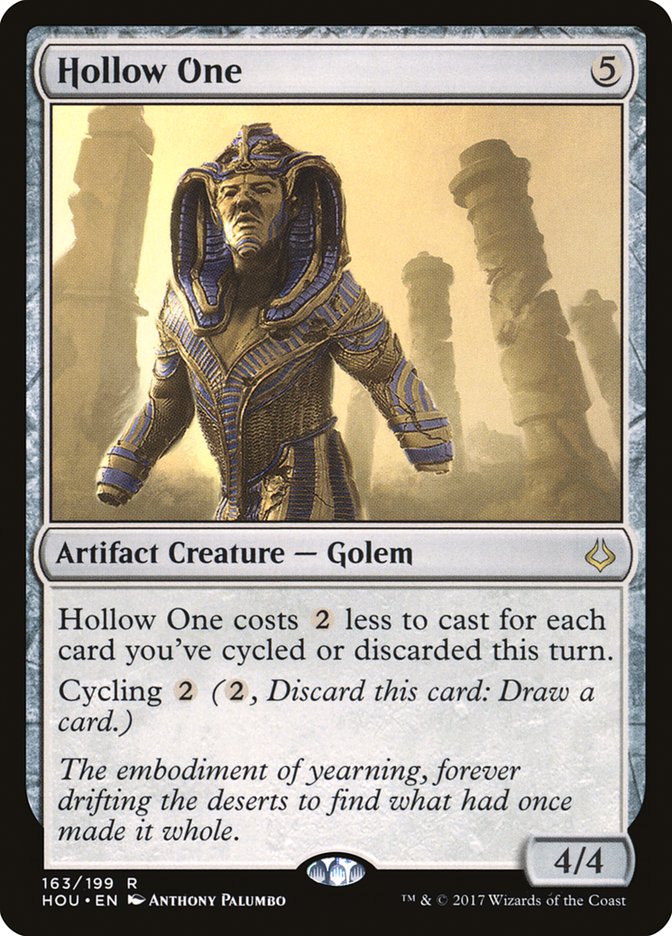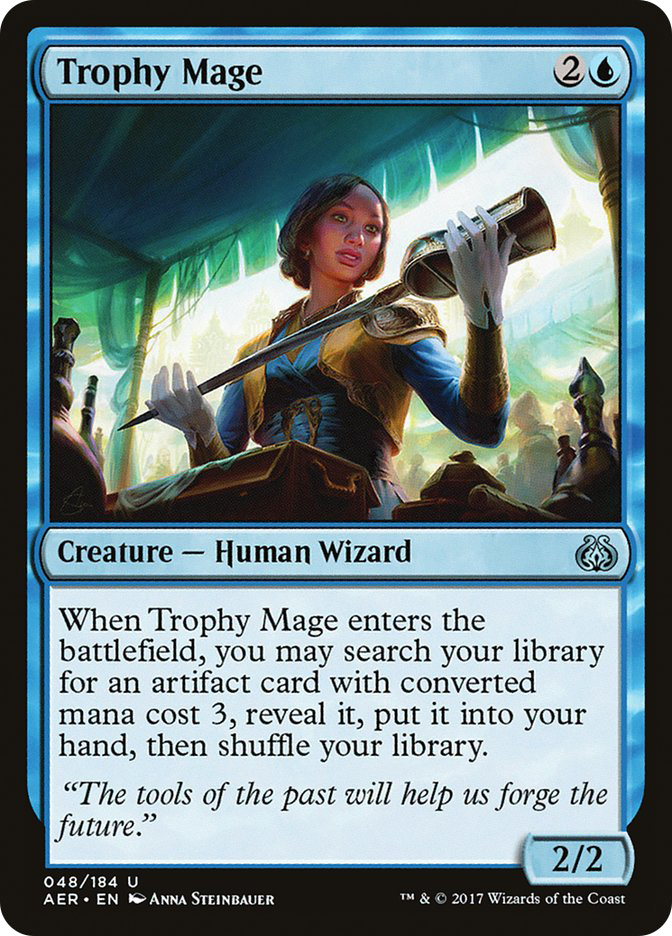This past week I’ve gotten countless messages and inquiries about the U/R God-Pharaoh’s Gift deck I posted last week and have played to a decent success rate with.

With the Regional Pro Tour Qualifiers being halfway done for this season and the back half just a couple of days away, I’ve all but written the list I’m playing out on a deck registration sheet. While I will come out and say that it’s not the deck I expected to be my frontrunner for the upcoming event, it is a deck I’ve had the most success with despite all my efforts elsewhere. The deck has explosive draws, is resilient to hate of all kinds, and has a great backup plan that people might not be ready for.
Creatures (29)
- 1 Pilgrim's Eye
- 4 Insolent Neonate
- 4 Angel of Invention
- 4 Glint-Nest Crane
- 4 Minister of Inquiries
- 4 Walking Ballista
- 4 Champion of Wits
- 4 Hollow One
Lands (11)
Spells (20)
Sideboard

There have only been very minor changes in the deck since I originally pieced together the puzzle. You’ll see that, since last week, I’ve changed the two copies of Filigree Familiar to a Pilgrim’s Eye and a fourth Aether Hub. Aside from that, there has only been a minor change of an Island being replaced by its ugly cousin Ipnu Rivulet.
So what are the problems with the deck?
Hollow One has consistently been underwhelming, but I feel it is a necessary evil to the deck. One pitfall I believe that many people will make when first picking up the deck is trying to make this card cost zero too often. Hollow One’s primary function in this deck is being an artifact.
However silly that may sound, there have often been times when I would have accepted my Glint-Nest Crane find me a copy of Darksteel Relic. While that may seem strange, it goes to show how polarizing the card Glint-Nest Crane is for the deck. It’s either the best or worst card in most situations and often the risk of missing isn’t even worth playing the card. Glint-Nest Crane is the card that I think pushed this deck over the top for me, since, while it doesn’t always find the Gate to the Afterlife, it puts four cards that aren’t Gate to the Afterlife on the bottom of your deck, which can be all you need from the card.
With all that in mind, Hollow One certainly isn’t necessary to the success of the deck, but I do like the added benefit of being able to cycle a random artifact Glint-Nest Crane can hit that isn’t Gate to the Afterlife, with the added benefit of doing a great Hooting Mandrills impression on occasion.
Many people have suggested the addition of Trophy Mage to the deck, as we’re pretty bent on finding Gate to the Afterlife every game. One issue I’ve found with a card like that is it is our turn 3 play instead of Gate to the Afterlife itself. While you can’t always have Gate to start every game and ways to find it are pretty great, having the way to find it be a three-drop means that you’re not going to be able to sacrifice the Gate to the Afterlife until turn 5, and potentially not even then unless you have five mana available, which doesn’t always happen with this deck, as we’re only playing 21 lands. In a deck with around 23 lands, I could certainly see Trophy Mage being a viable option, as you’d more consistently be hitting that fifth land on turn 5. A list like that might look something like this.
Creatures (27)
- 4 Insolent Neonate
- 4 Angel of Invention
- 4 Glint-Nest Crane
- 4 Minister of Inquiries
- 3 Trophy Mage
- 4 Walking Ballista
- 4 Champion of Wits
Lands (12)
Spells (21)

We would in all likelihood have to remove the Hollow Ones from the deck to make room for the additional lands as well as the Trophy Mages themselves. I’m sure this gives the deck some additional consistency, seeing as you have more ways to find copies of Gate to the Afterlife early on, but it greatly decreases the amount of hits you have for Glint-Nest Crane from fifteen to only ten. While you can mitigate the damage that Glint-Nest Crane might cause by missing more frequently in this version by simply discarding it to Cathartic Reunion, Insolent Neonate, or Champion of Wits, the 1/3 blocker is exceedingly relevant against decks like Ramunap Red and it still deserves a slot.
Back to the original list and some potential problems the deck might have, we come to the sideboard. I’ve yet to completely configure a sideboard plan against even the most popular decks. With a lot of Standard being all about picking and choosing what sideboard configuration you like the best, this Standard format has more cards in it than we’re used to making it all the more difficult.
Currently these are the cards available to this deck I’ve found most effective in post-sideboard games. Another question that people often ask is how you beat sideboard cards like Crook of Condemnation, Dispossess, and Scavenger Grounds or more common maindeck cards such as Abrade. While those cards can pose an issue for the deck at certain points of the game, I’ve beaten every possible hate card in the format all the way down to The Scarab God thanks to the sideboard.
Much like various control decks in the format, having a semi-transformational sideboard can go a long way against a player getting tunnel vision and only gunning for your Plan A of God-Pharaoh’s Gift. Traditionally a card like Kalitas, Traitor of Ghet is a big issue if your opponent gets that down before you can get your God-Pharaoh’s Gift active. However, an easy fix to that is having cards that prey upon Chandra, Torch of Defiance and Glorybringer, turning their haymaker in the matchup into a card you’re able to easily throw by the wayside, gaining huge amounts of tempo.
Cards like Chaos Maw and Chandra’s Defeat are very helpful against Ramunap Red since, while they don’t have great answers to a 6/6 flying, lifelink, haste, vigilance Angel of Invention, it can be difficult if you don’t get your God-Pharaoh’s Gift online quickly or if they Abrade it. Chandra’s Defeat also has dual applications against the Temur Energy decks that have returned in popularity as of late, killing both Chandra, Torch of Defiance and Glorybringer for only a single mana.
I’m not sure Negate entirely belongs; it feels more like a necessary evil than anything else. What I mean when I say that is while Negate can be your best card against a deck such as U/R Control or the U/W Approach deck, the U/R God-Pharaoh’s Gift deck wants to tap out at almost every turn, leaving you little opportunity to hold open two mana. It’s not a card I’m looking to replace in the sideboard, but it’s one I’m not thrilled about.
I’ve heard arguments for some number of copies of Dispel to fight counter wars against control, but the upside of being able to stop Hour of Promise, Refurbish and even Hour of Devastation in certain situations is too much of an upside. While Negate does have a lot of implications and offers a layer of protection to the deck against some of the powerful noncreature spells running around at the moment, getting too clogged up with Negates can leave you not executing your gameplan in a timely manner, causing more harm than good.
The only hole in the sideboard I’ve come across in the last week’s worth of testing is the fourth copy of Glorybringer. While it’s good in a fair few matchups, there is the danger of oversideboarding and cutting more cards than you need to. What that means is that we should be a bit more flexible with our sideboard cards and maybe cut a Glorybringer for another unique card that offers us something the deck can’t do as is.
If I had to submit a deck list for the RPTQ this exact second, it would look like this.
Creatures (29)
- 1 Pilgrim's Eye
- 4 Insolent Neonate
- 4 Angel of Invention
- 4 Glint-Nest Crane
- 4 Minister of Inquiries
- 4 Walking Ballista
- 4 Champion of Wits
- 4 Hollow One
Lands (11)
Spells (20)
Sideboard

Abrade seems like a missing piece to help deal with a potential mirror match or against any God-Pharaoh’s Gift variant. It offers some additional removal against early aggression or if you’re feeling you need to deal with Gearhulks of every kind, it’s got you covered.
I did mention a lot of decks being viable last week in my article, so going through all of them with a sideboard guide would be a marathon of a task. I’ll cover the matchups I wouldn’t be shocked to see sitting across from me this weekend at the RPTQ.
Ramunap Red
Out:
In:
There’s not much that you need to sideboard in this matchup. Their deck struggles with a Gifted Angel of Invention and you’re often likely able to catch them at a point where they don’t have Abrade mana up to get a one-shot trigger of God-Pharaoh’s Gift, which is almost always enough. The plan here is cut some of the slower, less consistent cards and bring in a few removal spells to buy you time. Even though you’re going lower on the artifact count, Glint-Nest Crane still shines as a 1/3 here.
Mono-Black Zombies
Out:
In:
It may seem strange to cut a copy of Walking Ballista in this matchup, but the primary threat you need to answer in this matchup is Kalitas, Traitor of Ghet. They’re likely going to have two or three copies of the card in their 75 and it’s the only card that you really have to make sure doesn’t survive. Chaos Maw is almost exclusively for this matchup, since they’re so capable of flooding the battlefield and removing your primary win condition in Angel of Invention with the various removal spells they can bring to the table.
This is also one of the few matchups where I’d worry about a card like Dispossess, which puts an even greater emphasis on having more castable cards like Chandra, Torch of Defiance that can both answer Kalitas, Traitor of Ghet as well as win the game on its own if protected.
B/G Constrictor
Out:
In:
This matchup has been rather easy from what I’ve found. Yes, they can have a bunch of hand disruption as well as some copies of Kalitas, Traitor of Ghet, but they’re slower out of the gates than both Ramunap Red and Zombies, meaning you have more time to set up as well as just play a normal game with your powerful big red cards out of the sideboard.
Mardu Vehicles
Out:
In:
This deck has always been looming near the top tables of Standard since the release of Kaladesh and has picked up a bit online again the past few weeks. You don’t need much here. Abrade is a nice card to be able to fight Heart of Kiran, but I wouldn’t want to dilute our gameplan too much; they function on a single axis of playing creatures and removal, which is something God-Pharaoh’s Gift can easily overcome.
Temur Energy
Out:
In:
Walking Ballista isn’t too relevant here and their deck is better at fighting a Chandra, Torch of Defiance and Glorybringer war than we’re capable of. Chandra’s Defeat helps deal with an early Chandra, Torch of Defiance and Glorybringers off the top. You’re able to out-card them here with Champion of Wits and usually invalidate their aggression with a single God-Pharaoh’s Gift trigger. They do play Abrade, but that’s not enough to make me want to bring in Negate almost ever.
G/R Ramp
Out:
In:
This matchup is just a race. You can’t beat Ulamog, the Ceaseless Hunger and they have a fair bit of removal to slow you down. I wouldn’t say this is a matchup I really want to play against, but it is winnable if you’re able to get an early God-Pharaoh’s Gift down. “Counter their ramp spell on turn 3 and hope that buys you enough time” is the game plan.
U/W Approach
Out:
In:
This is not a matchup I’m terribly familiar with. The primary way I’ve found you win this matchup is just beating down with a lot of your creatures. Shaving numbers here and there might not be correct, but Minister of Inquiries isn’t too great when they’re likely to Wrath you, which would fill your graveyard as is, and Cathartic Reunion can be a liability against counterspells but is still one of the best cards in the deck.
You don’t really need to kill things with Glorybringer or Chandra, Torch of Defiance in this matchup, but having additional castable threats is pretty important. Just play around Censor with your important cards like Gate to the Afterlife and be sure to pressure the turns they’re holding up mana for Glimmer of Genius with important spells and you should be fine.
U/R Control
Out:
In:
Same sideboard plan here as against U/W Approach. Even though they’re different decks on the same sideboard plan, the matchup is much more difficult because of Abrade. They get cheap ways to counter your important spells and the best way to kill your God-Pharaoh’s Gift. Not only that, but their threats aren’t seven-mana sorcery-speed ones like Approach of the Second Sun but flashy Torrential Gearhulks that serve as both additional answers to your threats and ways to generate insurmountable advantage going late.
This is probably the toughest matchup for the deck, but not one I’m sure I’ll face. I don’t think control is a great choice for an RPTQ, since it’s hard to know what to expect, and not having the right answers at the right times is much harder than having the right threats at the right times.
Another side note with this deck that might not be apparent to someone picking it up for the first time is thinking your entire turn out before taking any action each turn. Something as simple as playing the wrong land or even playing a land could cost you the game.
It can be right or wrong to hold lands if the game goes a little later than intended because of topdecks like Cathartic Reunion and Champion of Wits. It could be right to play lands so you could just hard-cast God-Pharaoh’s Gift if drawn. The margins on this deck are very small, but they are there, and if you can’t take advantage of them by knowing all the ins and outs of the deck, you’ll be leaving a lot of games on the table.
Those are all the decks I’d expect people to play at the upcoming RPTQ and how I plan on attacking the with the U/R God-Pharaoh’s Gift deck. Hopefully this has been helpful to those looking to play it this weekend. Good luck to everyone at their RPTQ’s! Let me know if you’re playing the deck in the comments and how you do!




